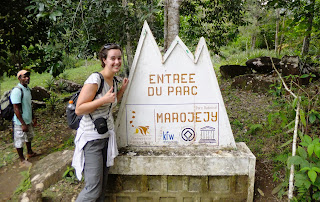 |
| Snuggling Millipedes |
In this picture you can see Madagascar in purple, squished between India and Africa. It was once a part of mainland Africa. But over time, the plates shifted and the land changed. Madagascar ended up on its own. Over thousands of years, plant and animal species started changing in order to adapt to their environment. Plants and animals in other parts of the world changed too, but the land was different so they adapted in different ways. Because Madagascar has been an island, on its own, for so long, the animals were kind of stuck out there, unable to roam around the other continents. The result was a huge difference in species from Madagascar and everywhere else in the world. Now it's famous for having some of the world's most unusual creatures!

I headed out on my fourth day in the country to try to see some examples for myself. Le Parc National de Marjojey is on the Northeast coast of Madagascar. 70% (so 7 out of 10) things in the park are endemic (only found in) Madagascar. So almost everything I saw when I looked around was something I'd never seen before! Pretty cool, eh? I hiked through the rainforest, a bamboo forest, and up a mountain in search of one of Madagascar's most famous animals-lemurs! Along the way, my guide helped me find another cool creature-the chameleon.
In my previous travels I have seen many monkeys, and I had expected lemurs to be similar. They both live in trees and have tails... it seemed simple. Although related (they're both primates), they are quite different.
Lemurs have a longer snout and bushier tails. The thing I noticed first, though, was the difference in how they jump. When I've watched monkeys jump, I've noticed how they make an arch in the air. They reach out with their arms and jump towards a group of branches. Their tail usually flails up in the air. The types of lemurs I saw, however, spring off their hind legs and bounce up. Their tail hangs below them. They often jump to a specific tree trunk and are capable of landing and jumping again all in one motion. They also seem to be more confident climbing down backwards, more like a human and less like a monkey.
The trek I did was hard work-three days/two nights in the rainforest. It was really slippery after it rained! The campground had cabins on stilts so they wouldn't get wet when it rained and each cabin had two bunk beds. It's so humid in the rainforest that your clothes stay wet even if you hang them overnight. It was not a nice feeling to put on wet clothes the second and third day!
Here are a few other photos from the trip:
 |
| White-Faced Brown Lemur |
Lemurs have a longer snout and bushier tails. The thing I noticed first, though, was the difference in how they jump. When I've watched monkeys jump, I've noticed how they make an arch in the air. They reach out with their arms and jump towards a group of branches. Their tail usually flails up in the air. The types of lemurs I saw, however, spring off their hind legs and bounce up. Their tail hangs below them. They often jump to a specific tree trunk and are capable of landing and jumping again all in one motion. They also seem to be more confident climbing down backwards, more like a human and less like a monkey.
Eastern Grey Bamboo Lemur
Silky Sifaka
The trek I did was hard work-three days/two nights in the rainforest. It was really slippery after it rained! The campground had cabins on stilts so they wouldn't get wet when it rained and each cabin had two bunk beds. It's so humid in the rainforest that your clothes stay wet even if you hang them overnight. It was not a nice feeling to put on wet clothes the second and third day!
Here are a few other photos from the trip:














No comments:
Post a Comment